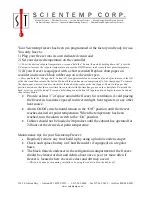
National Electrical Code and local codes. Do not plug in the
cabinet to overloaded power lines.
Consult a licensed electrician if you have ANY doubt
about the grounding of your wall receptacle. Only a
licensed electrician can determine the polarization of
your wall receptacle.
6 DANGERS OF A LOW TEMPERATURE FREEZER
Any temperature below 0
Centigrade or 32
Fahrenheit
provides a potential condition to cause freezing of water or
material containing water. Material containing water
solutions of salt or sugar will freeze at a slightly lower
temperature, depending on the content of the solution.
Because all warm-blooded creatures are composed of a great
percent of water with salinity, they are subject to freezing
whenever the body cells, parts or extremities reach
temperatures below freezing.
6.1 When Skin Freezes
When your skin is exposed to subfreezing temperatures for
an extended amount of time, it can freeze. Your blood
vessels constrict in response to dropping temperatures. This
reduces the flow of blood and, therefore, the amount of
oxygen to the tissues. When water in these tissues freezes
and forms ice crystals, cell structure is destroyed.
Tissue damage from cell death interrupts circulation in the
smallest blood vessels. Blood clots form and blood flow is
further diverted away from the frozen tissue. At this point,
your skin temperature drops and the injured area grow even
colder.
The first sign of frostbite may be a slightly painful tingling
sensation, which often is followed by numbness. Your skin
may look pale, and feel hard, cold and numb.
In the event of frostbite, warming is vital. Carefully warm
frost bitten areas gradually. Place your hands directly on the
skin of warmer areas of your body. If possible, immerse
your hands in water that is slightly above normal body
temperature (about 100
F or 37.8
C), or which feels warm to
someone else, until your normal color returns. Do not use
direct heat. Seek medical attention as quickly as you can.
7 REFRIGERATION COMPARTMENT
The refrigeration system of a Scientemp freezer is
hermetically sealed. It requires no maintenance. However, in
areas where excessive dust and dirt collects, the condenser
must be kept clean. To clean the condenser, remove power to
freezer. Refer to instruction sheet in this packet on how to
get to the condenser. If you need another copy, one can be
found and downloaded on our website. You can also contact
us and we can email you one.
7.1 Fan
The fan motor has lifetime lubrication. It requires no
maintenance.
7.2 Frost removal
1.
While the freezer is running the frost may be
removed with a plastic or wooden scraper or
spatula. Do not use metal or sharp objects such as
an ice pick, as this will cause serious damage to the
finish of the inner-liner of the freezer. The frost and
ice may be collected in a pan, towel or any device to
prevent it from falling to the bottom of the freezer
or onto the material stored in the freezer. Most of
the frost and ice collects near the top edge and is
easily removed.
2.
In the case where the freezer is not loaded, frost and
ice may be removed by disconnecting the power
until the frost and ice thaw. After defrosting, dry
the freezer compartment interior and plug freezer
back in.
*CAUTION: Wear protective clothing while either
handling or coming in contact with inside of freezer.
Hands should be dry and protected by using gloves.
Insulated gloves are best for extended use when
handling frozen product. Sleeves or arm-length
insulated gloves should protect arms. Coats,
insulated aprons, etc. should protect other parts of
the body that may be exposed to the cold.



























